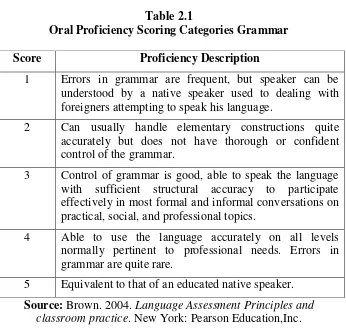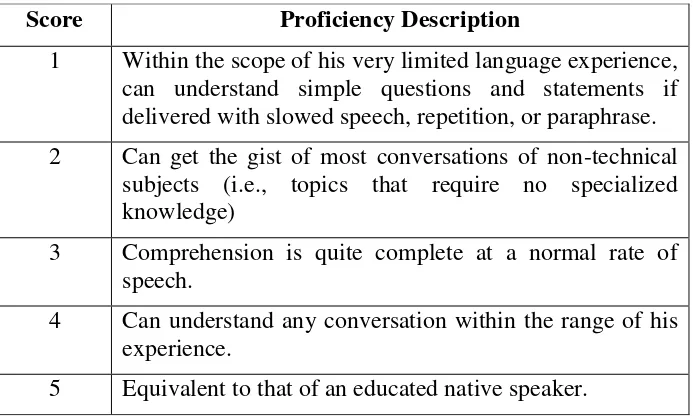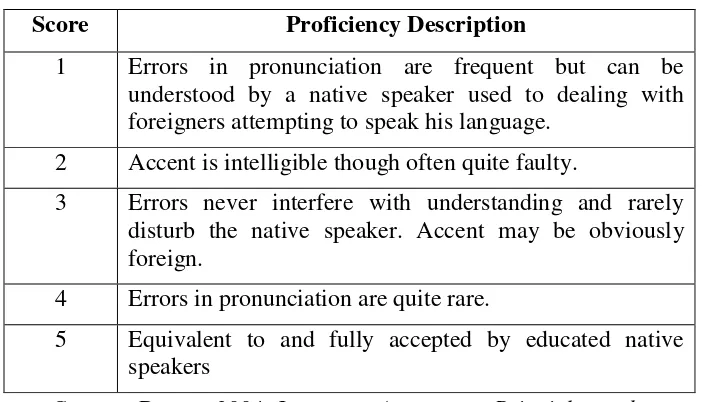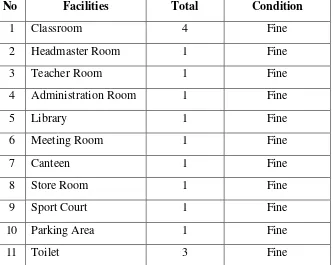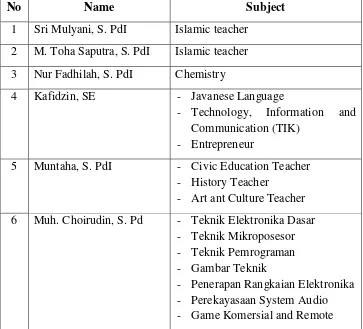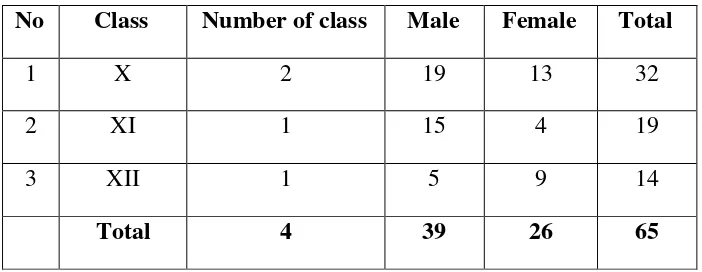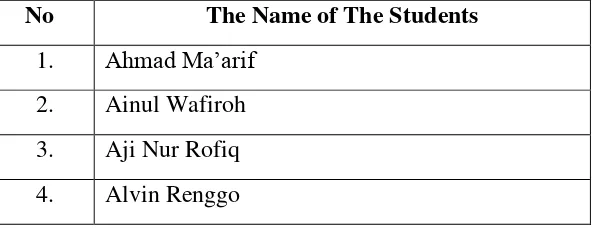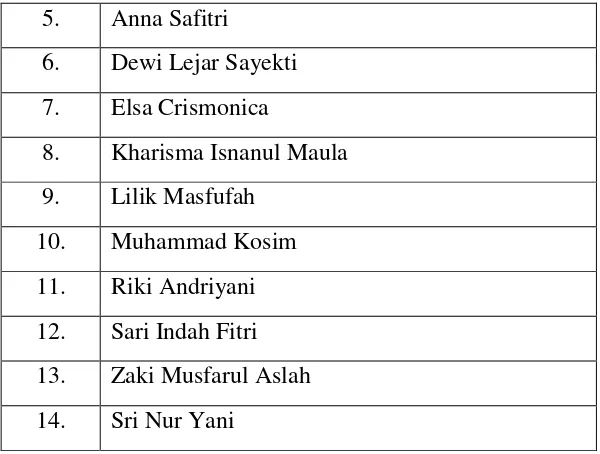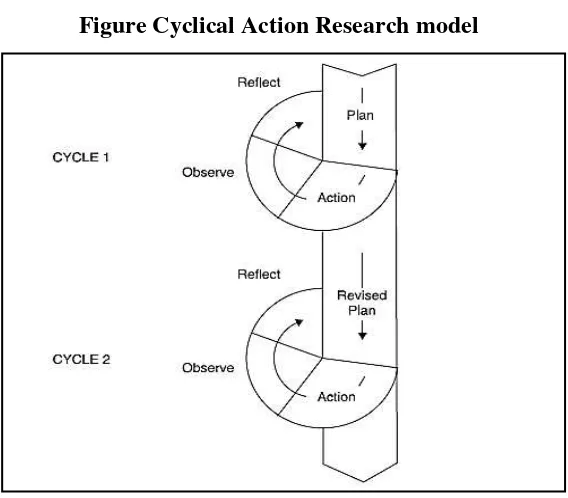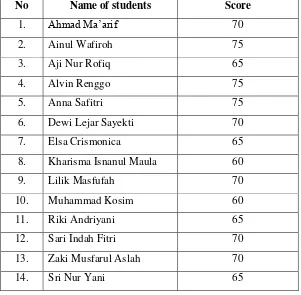IMPROVING SPEAKING SKILL THROUGH SMALL
GROUP DISCUSSION
(A Classroom Action Research for the Third Grade
Students of Vocational Secondary School Pancasila
Salatiga in the Academic Year 2015/2016)
A GRADUATING PAPER
Submitted to the Board of Examiners as a partial fulfillment of the
requirements for the degree of Sarjana Pendidikan Islam (S.Pd.I)
English Education Department of Teacher Training
and Education Faculty
State Institute for Islamic Studies (IAIN) Salatiga
By:
HONANG ADI RIYANTO
113 11 114
ENGLISH EDUCATION DEPARTMENT
TEACHER TRAINING AND EDUCATION FACULTY
STATE INSTITUTE FOR ISLAMIC STUDIES (IAIN)
MOTTO
ْعِفُر ِه ِدا
َقِتْعا َب ْسَح يَتَفْلاِذِا
ْع ِف
َتْ َ ْ َل ْ ِقَتْ َ ْ َل ْ َ لُّ ُ َ
“The Magnificence of somebody is measured by his
determination, No success without determination
(Syech Syarifuddin Yahya al-
'Imrithi)”
Rock the World
DEDICATION
I dedicate this graduating paper to:
Allah Subhanahu Wata’alaa . . .
All of my family, especially for my Wonder woman, my mother (Mrs.
Patemi) and grandmother (Mrs. Karsini), thanks for everything. You are my
everything
My Brother (Rowi Ilham Nugroho) and Sister (Maulida Safa’atun Najwa).
Your smiles give me power to always stand up.
My uncle (Om Suhadi, SKM., MMKes) thanks a lot for the life experiences,
support, help and guidance for me. You’re th
e Best for me.
Thanks for all of my family in Salatiga, especially for Abah Kyai Muhlasin
and Umi Choiriyatik for your praying and guidance. For all of my best
friends in Pon-Pes Pancasila Salatiga thanks for your kindness,
brotherhood, love, and smile and soon. I will never forget it.
Thanks for Mbah Kyai Selamet Idris and his family, thanks so much. For
all of My Friends in Pon-Pes Al-Ishlah, you are the best.
ACKNOWLEDGEMENT
All praise due to Allah, the Most Gracious and the Most Merciful because of His wonderful blessing and His mercy, the writer can finish this graduating paper successfully. The incredible blessings make realize that nothing is impossible in the eyes. Thanks for Your will and endless blessing in my life.
Peace and salutation always be given to our beloved prophet Muhammad SAW that Moslem hopes his blessing in the Judgment day. However, this success would not be achieved without the support, guidance, advice, help and encouragement from individuals and institutions. Therefore, the writer would like to express the deepest gratitude to:
1. Dr. Rahmat Hariyadi, M. Pd., the Rector of State Institute for Islamic Studies (IAIN) Salatiga.
2. Suwardi, M. Pd., the Dean of Teacher Trainig and Education Faculty of State Institute for Islamic Studies (IAIN) Salatiga.
3. Noor Malihah, Ph. D., as the Head of English Education Department. 4. Faizal Risdianto, S. S., M. Hum. as my academic counselor thanks for
your support and guidance.
6. All lecturers of English Education Department of IAIN Salatiga, thanks for your advice, knowledge, and kindness.
7. Mrs Sri Mulyani, S. PdI as the Headmaster of Vocational Secondary School Pancasila Salatiga and all of teachers and students, especially for my teacher counselor Mrs. Dyah Daniati, S.PdI, thanks for your kindness, help, guidance and advice.
8. My beloved family who always support and advise me.
9. My best friends (Nafik, Faiz, Dzulfikar, Luthfi, Hasan, Wahyu and Rifqy), thanks for being by my side for your support and success for you all. 10. All of my friend in IAIN Salatiga, especially for English Education
Department in the cohort of 2011, from A class until E class whose names cannot be mentioned one by one, thanks for being my friends.
11. The Big Family of Al Khidmah Kampus Kota Salatiga (Kang Mirza, Kang Irsyad, Kang Ghoni dll) Thanks for anything.
Finally, this graduating paper is expected to be able to provide useful knowledge and information to the readers.
Salatiga, August 22th 2015 The writer
ABSTRACT
Riyanto, Honang Adi. 2015. Improving speaking skill through small group discussion (a classroom action research for the third grade students of Vocational Secondary School Pancasila Salatiga in the academic year 2015/2016). Graduating Paper English Education Department of State Institute for Islamic Studies (IAIN) Salatiga. Counselor: Mashlihatul Umami, S.Pd.I, M.A.
Keywords: Improving speaking skill, small group discussion.
TABLE OF CONTENTS
TITLE ... i
DECLARATION ... ii
ATTENTIVE COUNSELOR NOTES ... iii
STATEMENT OF CERTIFICATION ... iv
MOTTO ... v
DEDICATION ... vi
ACKNOWLEDGMENT ... vii
ABSTRACT ... ix
TABLE OF CONTENT ... x
LIST OF FIGURES ... xiii
LIST OF TABLES ... xiv
LIST OF CHARTS ... xvi
CHAPTER 1 : INTRODUCTION A. Background of the Research ... 1
B. The Research Questions ... 6
C. The Objectives of the Research ... 7
E. Previous Research Review ... 8
F. Benefits of the Research ... 9
G. Definition of Key Terms ... 10
H. Outline of the Paper ... 11
CHAPTER 1I : LITERARY REVIEW A. General Concept of Speaking Skill ... 13
1. The Definition of Speaking Skill ... 13
2. The Elements of Speaking Skill ... 17
3. Types of Speaking Skill ... 20
4. Teaching Speaking Skill ... 21
5. Assessments of Speaking Skill ... 22
6. The Suggestions of Speaking Skill ... 26
B. General Concept of Small Group Discussion ... 28
1. The Definition of Small Group Discussion ... 28
2. The Techniques of Small Group Discussion ... 29
3. The Competencies which are Develop through Small Group Discussion ... 30
4. The Characteristics of Small Group Discussion ... 31
5. The Roles of Small Group Discussion ... 34
6. The Advantages of Small Group Discussion ... 36
1. Site of the Research ... 38
2. Time of the Research ... 45
B. Methodology of Research ... 46
1. The Definition of Classroom Action Research ... 46
2. The Characteristics of Classroom Action Research ... 47
3. Approach of the Research ... 48
4. Type of Research ... 48
5. The Procedures of Research ... 49
6. The Technique of Collecting Data ... 51
7. Data Analysis Method ... 53
CHAPTER IV : IMPLEMENTATION OF THE STUDY A. Field Note ... 56
1. Cycle 1 ... 57
2. Cycle 2 ... 76
B. Analysis and Discussion ... 89
CHAPTER V : CLOSURE A. Conclusions ... 97
B. Suggestions ... 99
REFERENCES
LIST OF FIGURES
Figure 2.1 Speaking Skills for Effective Communication ... 15
LIST OF TABLES
Table 2.1 Oral Proficiency Scoring Categories Grammar ... 23
Table 2.2 Oral Proficiency Scoring Categories Vocabulary ... 23
Table 2.3 Oral Proficiency Scoring Categories Comprehension ... 24
Table 2.4 Oral Proficiency Scoring Categories Fluency ... 24
Table 2.5 Oral Proficiency Scoring Categories Pronunciation ... 25
Table 2.6 Oral Proficiency Scoring Categories Task ... 25
Table 3.1 The Situation of Educational Facilities of Vocational Secondary School Pancasila Salatiga ... 40
Table 3.2 The Situation of the Teachers and Staffs of Vocational Secondary School Pancasila Salatiga ... 41
Table 3.3 The Situation of the Students of Vocational Secondary School Pancasila Salatiga ... 43
Table 3.4 The Name of Subject of the Study of Vocational Secondary School Pancasila Salatiga ... 44
Table 3.5 The time of Research at Vocational Secondary School Pancasila Salatiga ... 45
Table 3.6 Scoring Rubrics ... 51
Table 4.2 The Result of Oral Test Cycle 1... 74
Table 4.3 The students‘ Score of Pre-test and Post-test in Cycle 2 ... 84
Table 4.4 The Result of Oral Test Cycle 2... 87
Table 4.5 The Mean and T-Calculations of Students‘ score ... 89
LIST OF CHARTS
Chart 4.1 The Mean and T-calculation of Students‘Score ... 89
CHAPTER I
INTRODUCTION
A. Background of The Research
Looking at the developing science and technology, our country will face Asian Economic Community (AEC) 2015. Everyone has to prepare anything before it. It is like a language. Language has an important role for them. They can express their ideas, emotion, and desires by using language. It is used as a medium to interact with one another and fulfil their daily need. There are many languages that can be used to communicate with other people in this world. Everyone has one or more languages that they usually use to communicate with others.
In our country, Indonesia, there are many languages that can be found there. If we do not have a language, I think that we cannot communicate with others. So, it is important for us to have language communicate skill. One of them is English. It is the international language in this world, so every country in this world studies about it. In Indonesia, English is as one of foreign languages which are taught in every educational institution.
they are supported by some factors such as the method that is used in teaching English, completeness of teaching facilitation, interesting media, and condition of school environment.
Teaching English in Indonesia is more difficult, because English is not the first language in our country, but, a foreign language and dominantly as a third language in this country. The researcher can conclude that teaching is a process of transferring knowledge, skills or science from one to another in order to make someone able to do or know what he/she does not know or cannot do before.
The Indonesian students have many difficulties to learn English. They do not have background in themselves about the English language yet. In elementary school moreover in play group or Kindergarten school, they can get the learning about English until finishing their education. Although they studied about English, they are still getting some difficulties to understand about English. So, there are students who can and cannot understand what the English is.
the freedom of communicate with English directly with their friends. They can improve their English skill with increasing their new vocabulary and making happy and funny with English. Thus, they can improve their English skill.
One of the vocational high schools in Salatiga which study about English is vocational secondary school Pancasila Salatiga. The students are obligated to follow the English language subject. It is included to be the main of one of subjects in the final exam to finish their study in their school. So, they must learn, learn and learn about English. But, English makes them to be afraid, so when they are studying English in their class they just keep silent and follow it, but they do not really understand it. Maybe it is first time for them, but the next times they will enjoy with English. They will little by little more understand about English. If they have the great desire, they will get it more easily.
Specially for speaking skill, it is one of the four skills of language. It is about how to express their desire with other orally. It will be important because if we want to get something we must express it verbally directly. So it is one of the ways to communicate with other people.
English to speak with each other; it is caused by condition of school environment and media that are used in teaching them.
Speaking is important for them to practice their capability and their understanding, how to send idea, and how to spell word well. In this case the students‘ motivation and interest are very needed to make the process
of their understanding more easily.
Because of the materials of English subject are various, so the teachers are obligated to choose the suitable approach, strategy, and method in order to achieve the teaching purposes more effectively. Meanwhile, the media will make the students to be more motivated to study. The teacher who is able to present the material easily will be students‘ idol. The teacher can use some methods in teaching learning process to help the students‘ understanding about the material that is
explained. In applying method, the teachers have to prepare many things like; teaching material, classroom management, and many other aspects because using inappropriate technique can make the students get difficulties in understanding the teacher‘s explanation and it means that the teacher may fail in teaching them.
Furthermore, the teacher has to prepare interesting aids before the teaching and learning process is done. In this case, the researcher used small group discussion as method in teaching learning processes.
Above of all, it is not the time to blame the students only in relation with the condition above. The technique used by the teacher also becomes a factor that determines whether or not the students can develop their speaking skill. According to Orlich et.al (1985) as quoted by Antoni (2014: 56) proposes that:
―Small group discussion could improve the student‘s speaking skill. There are 3 reasons why we can use small group-discussion in improving speaking skill. First group-discussion is used to increase teacher-student interaction and student-student verbal interaction in the classroom. Second, discussion is used to promote meaningful personal interaction and learning. The learning may be of contents, skills, attitudes or processes. Third, it is used to help students adopt more responsible and independent mode of learning.‖
Method must be able to increase the students‘ motivation in learning
English, especially in speaking English, and method has to be able to be understood. At last the teacher hopes that method can motivate his students to speak English to communicate their need especially in the classroom and in their daily need in general.
Besides, the researcher also uses authentic material as a media in improving students‘ speaking skill, authentic material is one of the best
book. Then, they are asked to analyze and comprehend the text itself. However, in the authentic material the teacher will give the texts without exercise book. It means that when the teacher teaches them, they will not only give the material based on the book, but also it is taken from the real situation and it is called the authentic material.
From the clarification above, the researcher is interested in conducting the research that will generate from the problem. So it is the reason why the researcher chooses the title “IMPROVING SPEAKING SKILL THROUGH SMALL GROUP DISCUSSION (A
CLASSROOM ACTION RESEARCH FOR THE THIRD GRADE
STUDENTS OF VOCATIONAL SECONDARY SCHOOL
PANCASILA SALATIGA IN THE ACADEMIC YEAR 2015/2016)”.
B. The Research Questions
It is necessary to formulate the scope of research, in order to avoid misunderstanding of the researcher about the subject matter discussed. The problems are:
1. How is the procedure of implementation of small group discussion to improve speaking skill for the third grade students of vocational secondary school Pancasila Salatiga?
3. To what extent does the use of small group discussion improve the speaking skill for the third grade students of vocational secondary school Pancasila Salatiga?
C. The Objectives of The Research
Generally the purpose of this research is to improve speaking skill for the third grade students in vocational secondary school Pancasila Salatiga. The purpose of this research, especially are to get information about:
1. To describe the procedure of implementation of small group discussion to improve speaking skill for the third grade students of vocational secondary school Pancasila Salatiga.
2. To find out whether there is improvement of speaking skill through small group discussion for the third grade students of vocational secondary school Pancasila Salatiga.
3. To find out to what the extent of the use of small group discussion improve speaking skill for the third grade students of vocational secondary school Pancasila Salatiga.
D. Limitation of The Research
E. Previous Research Review
In this graduating paper, the researcher took previous research from a collaborative research paper. It was the research arranged by Tika Rahmawati (2014) about the improving students‘ speaking skill through scaffolding talk technique. She conducted her research in MTs Negeri Andong for the eighth grade students in the academic year of 2013/2014. The findings are there is a significant after the students got scaffolding talk technique. It can be seen from the comparison between all the score of cycle I, cycle II. The findings display that the students‘ speaking skill
increases from pre to post test. The results showed that the mean of pre-test 47.08, the mean of post-pre-test 1, 66.67, and the mean of post-pre-test II 74.72. It means that scaffolding talk technique is able to improve the students‘ speaking skill.
The research conducted by the researcher for his graduating paper was different from the previous research. The researcher would cover about the using of small group discussion to improve the students‘
F. Benefit of the Research
The Benefits of this research are: 1. Theoretically
The findings of the research will give more explanation needed by English teacher especially how to improve the students‘ speaking skill through small group discussion. This means that small group discussion can improve the students‘ speaking skill. Students get more ways to improve their speaking skill. They will enjoy and are more interested in teaching learning process in their formal school after they get more knowledge from this research.
2. Practically
a. For the researcher
The findings of the research can be known that there are many ways or methods to improve researcher‘s English skill. b. For the students
The result of the research can improve their speaking skill better and also with this method they can get more knowledge not only in English education, but also in social relationship. They can interact or communicate with their friends in the groups.
c. For the English teacher
d. For the others researcher
The results of this research can be used as one of the references in contributing a research on English language teaching, especially to increase their English speaking skill.
e. For Vocational Secondary School Pancasila Salatiga
The result of this research can be used as a method to improving students‘ speaking skill in the school. The result of this
research can be functioned as information and reference for further researchers related with the field.
G. Definition of Key Terms
To avoid misunderstanding, the researcher gives definition of some key terms used in the research.
1. Speaking Skill
Brown (2004: 140) defines speaking as a productive skill that can be directly and empirically observed; those observations are invariably colored by the accuracy and effectiveness of a test-takers listening skill, which necessarily compromises the reliability and validity of an oral production test.
2. Small Group Discussion
everyone agrees, this book uses ―interaction‖ and ―communication‖ interchangeably. The two terms are considered to be synonymous).
Small group discussions can help learners develop a range of speech function and interaction management skills. These skills include using the spoken language to express viewpoints, negotiate ideas, explore options, express tentativeness, modify views, and agree and disagree (Christine, 2007: 38).
H. Outline of the Paper
This research is divided into five chapters. Each chapter explains different matters in line with the topic that is discussed.
The first chapter is introduction, which consists of background of the research, research questions, objectives of the research, limitation of the research, previous research review, benefit of research, definition of key terms, and paper organization.
The second chapter concerns with the theoretical review which consists of the definition of students‘ speaking skill, and the meaning of small group discussion.
general description of classroom action research, technique of collecting data, and technique of analyzing data.
The fourth chapter is the implementation of the research and data analysis. This chapter explains about the result of the research. It consists of two cycles and analysis.
CHAPTER II
LITERARY REVIEW
In order to make the problems clearer, the researcher explains them well in theoretical reviews. To clarify the references needed, the researcher discusses the definition of speaking skill and small group discussion method. A. General Concept of Speaking Skill
This concept will discuss about the definition of speaking skill, elements of speaking, types of speaking skill, teaching speaking skill, assessment of speaking and suggestions for speaking skill.
1. The Definition of Speaking Skill
Teaching English in any level, always involves four basic skills. They are listening, reading writing and speaking. However, in using English to communicate one another, we often use it orally or speaking, than the other skills. According to Brown (2004: 140) defines:
―Speaking as a productive skill that can be directly and empirically observed, those observations are invariably colored by the accuracy and effectiveness of a test-taker‘s listening skill, which necessarily compromises the reliability and validity of an oral production test‖.
states that speaking is the product of creative construction of linguistic strings, the speakers make choices of lexicon, structure, and discourse.
According to Goh, Christine (2007: 4-6) states that speaking is important for language learners. Besides the role it plays in communication, speaking can also facilitate language acquisition and development. In situations where the target language is also a language for instruction across the school curriculum, speaking is a crucial tool for thinking and learning. However, even when there are speaking activities, it is probably true to say that while speaking occurs, the skills may not necessarily be taught.
Teachers do not have a material of learner work which they could evaluate and give feedback on. As a result, problems that learners face when doing speaking activities often go unnoticed or uncorrected. There is much that we can do to ensure that speaking lessons are not merely opportunities for using language orally but are a means for learners to develop speaking skills and acquire the language.
Figure 2.1 Speaking Skills for Effective Communication
Phonological skills are important for effective oral communication. Learners should learn to articulate and blend vowels and consonants (‗phonemes‘) of the language that they are leaning. It is even more important, however, that they can use appropriate intonation to present their message as given and new information clearly to listeners (Brazil, 1985/1997). In this sense, phonological skills at the prosodic level can also play a role in organizing discourse.
Speech function skills are micro-skills necessary for achieving specific communicative ends in routine social and transactional exchanges (e.g. to greet, to agree, to complain, to offer a reason, to clarify etc.). Many language syllabuses that adopt communicative language teaching will show lists of common speech functions that are
Use spoken words to perform communicative functions, such as request, demand, and decline, explain, complain, encourage, beg, direct, warn and agree.
Interaction Management Skills
Manage face-to-face interactions by initiating, maintaining and closing conversations, regulating turn-taking, changing topics and negotiating meaning.
Extended Discourse Organization Skills
Interaction management skills are macro-skills for dealing with face-to-face spontaneous exchanges. These include the ability to initiate, sustain and end an interaction (e.g. conversations, discussions), offer and take conversational turns, modify or redirect the focus or topic of an interaction, and negotiate meaning to ensure that one understands what our interlocutors mean.
Extended discourse organization skills are another set of macro-skills for dealing with spoken interaction. Language learners often need to produce long stretches of language in various situations in and out of class. To ensure that their listeners understand what they say, learners need to be able to structure their spoken output in a way that is easy to follow. This requires knowledge of discourse routines, i.e. how a specific speech genre is structured (Bygate, 1998) as well as grammar and vocabulary knowledge for establishing coherence and cohesion. The ability to use intonation appropriately will be an asset.
It is important to add that effective oral communication does not depend on language and skills alone. Because of its status as an international language, English is now used by learners to communicate with native as well as other non-native speakers of the language. Learners from different countries must also have relevant cultural knowledge when speaking to one another. So, for example, the way disagreements are expressed may vary depending on whom we are speaking with and the roles we are adopting within that wider cultural context.
through the use of verbal and non-verbal symbols, in a variety of contexts.
From the above definition, it can be concluded that speaking is a crucial part of second language learning and teaching. Dealing with the importance of speaking, Azis also quotes Stoval (1998) states that language learners need to recognize that speaking involves three areas of knowledge:
a. Mechanics (pronounciation, grammar, and vocabulary): using the right words in the right order with the correct pronounciation. b. Function (transaction and interaction): knowing when clarity of
message is essential (transaction/information exchange) and when precise understanding is not required (interaction/relationship building).
c. Social, cultural, and norms (turn talking, rate of speech, length of pauses between speakers, relative roles of participants): understanding how to take into account who is speaking to whom, in what circumstances, about what and for what reason.
2. The Elements of Speaking Skill
a. Connected speech: effective speakers of English need to able to produce the individual phonemes of English. In connected speech sounds are modified (assimilation), omitted (elision), added (linking) or weaken (through contraction and stress patterning). It is for this reason that we should involve students in activities designed specifically to improve their connected speech.
b. Expressive devices: native speakers of English change the pitch and stress of particular parts of utterances, vary volume and speed of speech. By using these devices people will be able to show what and how they are feeling to whom they are talking to.
c. Grammar and lexis: spontaneous speech id marked by the use of a number of common lexical phrases, especially in the performance of certain language function.
d. Negotiation language: effective speaking benefit from the negotiator language. We use to seek clarification and show the structure of what are saying.
In addition, Harmer states concerning with other elements of speaking that is necessary to be mastered by a successful speaker. Those are mental/social processing and rapid processing skill that involves language processing, interaction and informing processing.
a. Language processing: effective speakers need to able to processlanguage in their own heads and put it into logical order so that it comes out in forms that are not only comprehensible, but also convey the meanings that are intended. Language processes involves the retrieval of words and phrases from memory and their assembly into syntactically and propositionally appropriate sequences. One of the main reasons for including speaking activities in language lessons is to help students develop habits of rapid language processing in English.
b. Interactive with others: most speaking involves interaction with one or more participants. This means that effective speaking also involves a good deal of listening, an understanding of how the other participants are feeling. A knowledge of how linguistically to take turns or allow others to do.
3. Types of Speaking Skill
According to Brown (2004: 141-142), in his book ―Language Assessment: Principles and Classroom Practices‖, states:
―Speaking is a productive skill that can be directly and empirically observed, those observations are invariably colored by the accuracy and effectiveness of a test-takers listening skill, which necessarily compromises the reliability and validity of an oral production test.
In the other page of his book, Brown says that there are five basic types of speaking. They are:
a. Imitative.
This type of speaking performance is the ability to imitate a word or phrase or possibly a sentence. (e.g., "Excuse me." or "Can you help me?") for clarity and accuracy.
b. Intensive.
This second type of speaking frequently employed in assessments context is in the production of short stretches of oral language designed to demonstrate competence in a narrow band of grammatical, phrasal, lexical or phonological relationships. c. Responsive.
d. Interactive.
Interaction can take the two forms of transactional language, which has the purpose of exchanging specific information, or interpersonal exchanges, which have the purpose of maintaining social relationships.
e. Extensive.
Extensive oral production tasks include speeches, oral presentations, and story telling, during which the opportunity for oral interaction from listeners is either highly limited or ruled out altogether.
4. Teaching Speaking Skill
According to Brown (1994: 268-269) states there are seven principles for designing speaking techniques:
a. Use techniques that cover the spectrum of learner needs, from language based focus on accuracy to message-based on interaction, meaning, and fluency.
b. Provide intrinsically motivating techniques.
c. Encourage the use of authentic language in meaningful contexts. d. Provide appropriate feedback and correction.
e. Capitalize on the natural link between speaking and listening. f. Give students opportunities to initiate oral communication. g. Encourage the development of speaking strategies.
From above explanation, we can see that all of principles for designing speaking techniques are very necessary for us. The need is passing the examinations to move to the next level and graduate from the school, and the general requirement is the students are able to speak and hold conversations. From a communicative purpose, speaking is closely related to listening. The interaction between these two skills is shown in the conversation.
5. Assessments of Speaking
Here the band score of oral proficiency scoring categories in speaking skill (Brown, 2004: 172-173). It can be seen on the tables below:
Table 2.1
Oral Proficiency Scoring Categories Grammar
Source: Brown. 2004. Language Assessment Principles and classroom practice. New York: Pearson Education,Inc.
Table 2.2
Oral Proficiency Scoring Categories Vocabulary Score Proficiency Description
1 Errors in grammar are frequent, but speaker can be understood by a native speaker used to dealing with foreigners attempting to speak his language.
2 Can usually handle elementary constructions quite accurately but does not have thorough or confident control of the grammar.
3 Control of grammar is good, able to speak the language with sufficient structural accuracy to participate effectively in most formal and informal conversations on practical, social, and professional topics.
4 Able to use the language accurately on all levels normally pertinent to professional needs. Errors in grammar are quite rare.
5 Equivalent to that of an educated native speaker.
Score Proficiency Description
1 Speaking vocabulary inadequate to express anything but the most elementary needs.
2 Has speaking vocabulary sufficient to express him simply with some circumlocutions.
3 Able to speak the language with sufficient vocabulary to participate effectively in most formal and informal conversations on practical, social and professional topics. Vocabulary is broad enough that be rarely has to grope for a word.
Source: Brown. 2004. Language Assessment Principles and classroom practice. New York: Pearson Education,Inc.
Table 2.3
Oral Proficiency Scoring Categories Comprehension
Source: Brown. 2004. Language Assessment Principles and classroom practice. New York: Pearson Education,Inc.
Table 2.4
Oral Proficiency Scoring Categories Fluency
within the range of his experience with a high degree of precision of vocabulary
5 Speech on all levels is fully accepted by educate native speakers in all its features including breadth of vocabulary and idioms, colloquialisms, and pertinent cultural references.
Score Proficiency Description
1 Within the scope of his very limited language experience, can understand simple questions and statements if delivered with slowed speech, repetition, or paraphrase. 2 Can get the gist of most conversations of non-technical
subjects (i.e., topics that require no specialized knowledge)
3 Comprehension is quite complete at a normal rate of speech.
4 Can understand any conversation within the range of his experience.
5 Equivalent to that of an educated native speaker.
Score Proficiency Description
1 (No specific fluency description refer to other four language areas for implied level of fluency)
2 Can handle with confidence but not with facility most social situations, including introductions and casual conversations about current events, as well as work, family and autobiographical information.
Source: Brown. 2004. Language Assessment Principles and classroom practice. New York: Pearson Education,Inc.
Table 2.5
Oral Proficiency Scoring Categories Pronunciation
Source: Brown. 2004. Language Assessment Principles and classroom practice. New York: Pearson Education,Inc.
Table 2.6
Oral Proficiency Scoring Categories Task
4 Able to use the language fluently on all levels normally pertinent to professional needs. Can participate in any conversation within the range of this experience with a high degree of fluency.
5 Has complete fluency in the language such that his speech is fully accepted by educated native speakers.
Score Proficiency Description
1 Errors in pronunciation are frequent but can be understood by a native speaker used to dealing with foreigners attempting to speak his language.
2 Accent is intelligible though often quite faulty.
3 Errors never interfere with understanding and rarely disturb the native speaker. Accent may be obviously foreign.
4 Errors in pronunciation are quite rare.
5 Equivalent to and fully accepted by educated native speakers
Score Proficiency Description
1 Can ask and answer questions on topics very familiar to him. Able to satisfy routine travel needs and minimum courtesy requirements. (Should be able to order a simple meal, ask for shelter or lodging, ask and give simple directions, make purchases, and tell time).
2 Able to satisfy routine social demands and work requirements; needs help in handing any complication or difficulties.
Source: Brown. 2004. Language Assessment Principles and classroom practice. New York: Pearson Education,Inc.
However, there are six components usually used to analyze speech performance, they are grammar, vocabulary, comprehension, fluency, pronunciation and task. The scoring also can include accuracy, articulation, eye contact, expression, intonation and gesture of the speaker. The researcher uses those speaking scoring rubric to collect data.
6. The Suggestions for Speaking Skill
Harmer (2007: 129-131) states the following activities are also helpful in getting students to practice ‗speaking-as-a-skill‘. Although
they are not level-specific, the last four will be more successful with higher-level students (upper intermediate plus), whereas the first two, in particular, are highly appropriate at lower levels (but can also be used satisfactorily with more advanced classes).
a. Information-gap activities: an information gap is where two speakers have different bits of information, and they can only complete the whole picture by sharing that information – because they have different information, there is a ‗gap‘ between them.
topics.
4 Would rarely be taken for a native speaker but can respond appropriately even in unfamiliar situations. Can handle informal interpreting from and into language. 5 Speaking proficiency equivalent to that of an educated
b. Telling stories: we spend a lot of our time telling other people stories and anecdotes about what happened to us and other people. Students need to able to tell stories in English, too.
c. Favorite objects: a variation on getting students to tell personal stories (but which may also involve a lot of storytelling) is an activity in which students are asked to talk about their favorite objects (things like MP3 players, objects with sentimental value, instruments, clothes, pictures, etc).
d. Meeting and greeting: students role-play a formal/business social occasion where they meet a number of people and introduce themselves.
e. Surveys: surveys can be used to get students interviewing each other.
f. Famous people: students think of five famous people. They have to decide on the perfect gift for each person.
g. Students presentations: individual students give a talk on a given topic or person.
h. Balloon debate: a group of students are in the basket of a balloon which is losing air. Only one person can stay in the balloon and survive (the others have to jump out).
B. General Concept of Small Group Discussion (SGD)
In this concept will discuss about the definition of SGD, the techniques of SGD, the characteristics of SGD, the competencies which are develop through SGD, the roles participant in SGD and the advantages and disadvantages of SGD.
1. The Definition of Small Group Discussion
Kindsvatter (1996: 242) states that:
―A small-group discussion dividing the large classroom into small groups of students to achieve specific objectives permits students to assume more responsibility for their own learning, develop social and leadership skills and become involved in an alternative instructional approach‖. According to Gulley (1960: 62) as quoted by Hastoyo (2010: 33) states a group is more than a collection of individuals assembled in the same place. He adds that the accomplishment of the group tasks has involved interaction.
He also quotes Hoover (1997:13), discussion is the process of talking things over among two or more persons, preferably face to face. He adds that the total discussion process ideally is a cooperative effort on the part of a number of individuals to work together as a group, through the exchange of thought orally, toward some group objectives. Risk states that discussion means thoughtful consideration of the relationship involved in the topic or problem under study.
―Thinking out some problems and situations together through verbal interchange of ideas is simply called as to dicuss. She also states that a discussion that works is primarily one in which as many students as possible say as much as possible. A further characteristic of a successful discussion is the apparent motivation of the participants: their attention to the speakers their expression that they are reacting to the humor, seriousness, or difficulty of the ideas being expressed.
From the explanation above, we can conclude that small group discussion is the method which consist of two or more persons in small group for exchange of thought orally to achieve a result in team work, and they can take assume more responsibility for their own learning, develop social and leadership skills and become involved in an alternative instructional approach. So, this method is better used in learning process.
2. The Techniques of Small Group Discussion
Dobson (1981: 62- 63) as quoted by Antoni (2014: 56) explains that discussion techniques for use in small group discussion are outlined as follows:
a. Divide the class into small group of three to six students each. Give each group a different discussion topic that will necessitate outlining of several important points. Have one student in each group to write down these points as they emerge from discussion by group members.
should elect a spokesman who will report on the group collective thoughts to entire class.
c. Call on the spokesman of one of the groups. After he gives a short presentation (five minutes or so), class members should question him or anyone else in the group in view point expressed. You can help general discussion along by addressing your own questions to members of the group.
Follow the some procedure with the remaining groups until all groups have given their presentation. Finally, the researcher uses the small group discussion to improve speaking skill for the third grade students of vocational secondary school Pancasila Salatiga in the academic year 2015/2016.
3. The Competencies Which are Develop Through Small Group
Discussion.
Small group discussion is very effective in achieving four types of learning outcomes:
a. Subject matter mastery. Small group discussion enables students to develop their understanding of the concept.
c. Attitude change and moral development. Small-group discussion plays role in building students‘ confidence and create cooperative
learning.
Communication skills. This technique is very helpful for students to engage in meaningful communication directed towards a goal or set of goals.
4. The Characteristics of Small Group Discussion
Martha in summary of citing internet sites said that the characteristics of small group discussion is
―Used to generate ideas in preparation for a lecture, film etc.; summarize main points in a text or reading; assess
levels of skill and understanding; reexamine ideas presented in previous classes; review exams, problems, quizzes, and writing assignments; process learning outcomes at the end of class; compare and contrast
theories, issues, and interpretations; solve problems that relate theory to practice; and brainstorm applications of theory to life‖.
She also said that on being an effective participant on class discussion describe five characteristics of effective in-class discussions. They are:
a. Positive interdependence: The group sinks or swims together. We achieve this goal in small group discussions in my courses when each group member shares a group task, a mutual goal, and common resources (a shared text or problem).
We achieve the goal of assisting, encouraging, and supporting each other in learning by the way we structure our classroom seating. Students are more able to learn together when you face each other in small circles. Students also support each other in learning when you make a commitment to solve problems jointly through discussion and shared explanations.
At first you may be disconcerted by group discussions. Sometimes students in my classes who have never participated in small groups approach their assigned tasks in highly individualistic ways. For example, rather than work together on a series of questions they have been asked to discuss, they decide that each student will work alone on one of the questions and share her/his answer with the others. I discourage the privatization of group work. More effective cooperative learning occurs when students maintain a commitment to sharing insights with each other. Four or five heads are better than one when it comes to responding to an assignment.
c. Individual accountability: Each group member has a responsibility to contribute to the group and do her/his "fair share."
when students divide group member roles among themselves. Typical roles include:
1) a team captain who keeps the group on task and focused. She/he reads the assignment to the group, mediates conflict, and manages time.
2) a recorder or clerk who takes minutes and writes down salient points. He/she also reports back to the class as a whole.
3) an encourager who gives team members feedback and is responsible for ensuring that all group members are heard. 4) a reflector who keeps track of dynamics of group process and
makes comments (to be turned in with the clerk‘s) about
focus, direction, organization, listening skills, participation of all members.
When students exercise these roles, they develop skills in leading, making decisions, building trust, and managing conflict. All of these skills are of value in today‘s workplace.
d. Group processing: Each group concludes their work together by sharing the results of their work with others.
understand and which need further discussion and reflection. Group reports also enable me to do my job better. One of my key responsibilities in class is to facilitate evaluation of your work. I listen to group reports in order to determine on which areas in our assignment students need further work. I offer guidance and further help with the assignment based on what I hear in the group reports.
e. Group assessment: Each group needs to regularly assess the effectiveness of its communication strategies and seek ways to improve group communication. Periodically, we reserve time in class to assess group dynamics. What is working? What isn‘t?
How can the groups function more effectively?. 5. The Roles of Small Group Discussion
the discussion on the topic, and developing time to periodic summaries.
The roles of recorder is to keep a record of discussion content. His job is to make a record of the important aspects of the discussion. One of his major responsibilities is to report to the group when requested. The observer are one of member in other groups or one of which is usually the instructor. The observers are given time at the end of each session to offer evaluations of group progress. The observer tries to observe what goes on in an objective manner and identifies the role which each member of the group is playing. The teacher as the instructor has a role as a consultant, guide, and resource person. The instructor‘s energies are used in creating and maintaining a mutual
feeling of responsibility to achieve group goals.
During the actions which the students are divided into some groups to discuss speaking material, the teacher will ask the group to share the role of each member in group. Some of the group members will be pointed as one recorder and one reporter. However, the most important is the activeness of the group members to participate during the lesson. How they contribute their speaking to solve the problem during the discussion. Here, the teacher‘s role is as the instructor and
6. The Advantages of Small Group Discussion
According to Hoover (1964: 250) as quoted by Hastoyo (2010: 48-49) there are number of values to be gained through the use of small group discussion:
a. It tends to develop group cohesion and responsibility. b. It encourages the timid person to participate.
c. It enables to develop greater creativity than would otherwise be possible.
d. It offers additional opportunities for leadership.
e. It may be used effectively to assit the class in planning and directing over-all learning activities.
It is also assumed that having a variety of group activities in the classroom will be effective in the way:
a. It helps teachers deal with differences among learners.
b. It provides opportunity for students to plan and develop special project on which groups can work together.
c. It increases students interaction and socialization.
CHAPTER III
RESEARCH METHODOLOGY
A. Site and Time of Research
1. Site of the Research
The research about improving speaking skill through small group discussion will take place at vocational secondary school Pancasila Salatiga. Explanations about the school are:
a. The General Situation of Vocational Secondary School
Pancasila Salatiga
This classroom action research is conducted at vocational secondary school Pancasila Salatiga. It is an educational organization under Yayasan Darul Muhlasin. The school was built on July 16𝑡ℎ 2005. The location is at Jl. Fatmawati No 11,
Kelurahan Blotongan, Kecamatan Sidorejo, Kota Salatiga 50715, and Propinsi Jawa Tengah. The number of phone is (0298)
315477. The e-mail of the school is
[email protected]. This location is strategic because this is easy to reach from any direction. It is also conducive for teaching learning process.
Yadi, S.Pd, as curriculum affairs, Kafidzin, SE, as students affairs, M. Toha Saputro, S. PdI, as relationship affairs, M. Muntaha, A.Md, as equipment affairs and Fatkurohim, S. PdI, as the chief of staff office.
Vocational secondary school Pancasila Salatiga is a private school. The major it has is electricity with the expertise focused on audio-video. For this year 2015/2016, this school adds one more major. It is tourism with the expertise focused on fashion and specified in only boutique fashion.
The total numbers of students‘ in academic year 2015/2016 are 65 students. They are consisting of 39 male and 26 female students. They consist of 32 students of ten year, 19 students of eleventh year and the students of twelve years are 14 students. b. Vision and Mission
1) Vision
Prepare graduates who are able to compete in global era and have high Koranic science.
2) Mission
a) Preparing graduates who are able to master technological science and Koranic Science
b) Preparing graduates who gear for working
c. The Situation of Educational Facilities
Educational facilities are all of building, equipment which is needed by teachers, students, and other educators in which provide by school to support teaching-learning process in school environment.
Good educational facilities are factors to be successful in teaching-learning process because all of students‘ need can be provided. The educational facilities can be seen in the table bellow;
Table 3.1
The Situation of Educational Facilities of
Vocational Secondary School Pancasila Salatiga in the Academic Year 2015/2016
No Facilities Total Condition
1 Classroom 4 Fine
2 Headmaster Room 1 Fine
3 Teacher Room 1 Fine
4 Administration Room 1 Fine
5 Library 1 Fine
6 Meeting Room 1 Fine
7 Canteen 1 Fine
8 Store Room 1 Fine
9 Sport Court 1 Fine
10 Parking Area 1 Fine
11 Toilet 3 Fine
d. The Situation of the Teachers and Staffs
Teacher is someone who learns knowledge for the students. Teachers teach materials and skills during the learning teaching process. They facilitate the students to get their talent. They have challenge to bring students in positive side not only in knowledge but also in moral values. Therefore, the teacher is important in teaching learning process. The situation of teacher in vocational secondary school Pancasila Salatiga as follows;
Table 3.2
The Situation of the Teachers and Staffs of Vocational Secondary School Pancasila Salatiga in the
Academic Year 2015/2016
No Name Subject
1 Sri Mulyani, S. PdI Islamic teacher 2 M. Toha Saputra, S. PdI Islamic teacher 3 Nur Fadhilah, S. PdI Chemistry
4 Kafidzin, SE - Javanese Language
- Technology, Information and Communication (TIK)
- Entrepreneur
5 Muntaha, S. PdI - Civic Education Teacher - History Teacher
- Art ant Culture Teacher 6 Muh. Choirudin, S. Pd - Teknik Elektronika Dasar
- Teknik Mikroposesor - Teknik Pemrograman - Gambar Teknik
7 Ambar, R. W., S.T - Teknik Kerja Bengkel - Teknik Dasar Elektronika - Teknik TV and Video - VCD, DVD and CD Player - Monitor Computer
8 Umi Fajriyah, S. Pd - Menggambar Busana - Membuat Pola
- Membuat Busana Wanita - Membuat Busana Anak 9 Qoiriah Martini, S. Pd MathematicTeacher 10 Laila Istiani, S. Si
Science Teacher 11 M. Qotibi, S. PdI Sport Teacher
12 Zulfatu Nikmah, S.Pd Indonesian Language Teacher 13 Fuad Ari Yadi, S. Pd. Ek - Hand Craft and Entrepreneur
- KKPI
- Teknik Dokumentasi Video 14 Diah Daniyati, S. PdI English Teacher
15 Edy Sulistiyono, S. Pd Physics Teacher 16 Samsul Choeri, S. PdI Chief of Staff Office 17 Khosidatul Hikmah Staff Office
18 Samsul Arifin Security
Source: Vocational Secondary School Pancasila Salatiga; 2015
e. The Profile of the Students
secondary school Pancasila Salatiga could be seen in the table bellow;
Table 3.3
The Situation of the Students of
Vocational Secondary School Pancasila Salatiga in the Academic Year 2015/2016
No Class Number of class Male Female Total
1 X 2 19 13 32
2 XI 1 15 4 19
3 XII 1 5 9 14
Total 4 39 26 65
Source: Vocational Secondary School Pancasila Salatiga; 2015
f. The Subject of the Research
The subject of the research is the third grade of student vocational secondary school Pancasila Salatiga. It is a small class that consists of 14 students. There are 5 male and 9 female. They have high motivation to study.
1) Population
According to Arikunto (2010: 173) states in
Encyclopedia of Educational Evaluation that: A population is a set (or collection) of all elements processing one or more attributes of interest.
academic year 2015/2016. The total population of this research is 65 students. There are 39 male and 26 female. 2) Sample
Based on Arikunto (2010: 174) ―sample is a part of population of the observations‖. The researcher takes the third grade students as the sample of this research. It consists of 14 students 5 male and 9 female.
3) Sampling Technique
In this research the researcher uses purposive sampling in order to reach a targeted sample quickly. The researcher takes this sampling technique because the English teacher in this school Mrs. Dyah suggested to the researcher to conduct the research in third grade. She also explained to the researcher that students in this class have high motivation to master English but them difficult to encourage and improve their knowledge.
Table 3.4
The Name of the Subject of the Research of Vocational Secondary School Pancasila Salatiga in the
Academic Year 2015/2016
No The Name of The Students
5. Anna Safitri
6. Dewi Lejar Sayekti 7. Elsa Crismonica
8. Kharisma Isnanul Maula 9. Lilik Masfufah
10. Muhammad Kosim 11. Riki Andriyani 12. Sari Indah Fitri 13. Zaki Musfarul Aslah 14. Sri Nur Yani
Source: Vocational Secondary School Pancasila Salatiga; 2015
2. Time of the Research
The time of the research is August 20th - September 5th 2015. Schedule of the research is as follows:
Table 3.5
The time of Research at SMK Pancasila Salatiga
No Activity Date
1. Observation August 20th 2015
2. Cycle I
The implementation of small group discussion in improving students‘ speaking skill.
Pre-test August 26th 2015
Post-test August 27th 2015
3 Cycle II
The implementation of small group discussion in improving students‘ speaking skill.
Pre-test September 3𝑡ℎ 2015
B. Methodology of Research
1. The Definition of Classroom Action Research
The research method used in this research is action research. Classroom action research was known and spoken in educational word. To know the meaning of classroom action research, according to Arikunto (2006: 2-3) there are three words that make those means. So, there are three definitions that can be explained.
a. Research is an activity to observe the object by using of ways and methodologies to get the useful data or information to improve the quality of thing and that is necessary for researcher.
b. Action is a movement activity deliberately with a specific purpose.
c. Class in this case is not bound by the terms of the classroom, but in a more specific sense. The terms of class in this case are a group of students who are in the same time; receive the same lesson from the same teacher as well.
2. The Characteristics of Classroom Action Research
Syamsuddin and Damaianti (2011:197) outline the following characteristics of classroom action research:
a. It examines problem which are deemed problematic by researcher in teaching learning process.
b. The researcher can give treatment which planed action to solve the problems and improve the quality, so the subject can get the implication.
c. The steps of research in the form of cycle.
d. Such reflective thinking from researcher both after and before research.
e. Contextual situational, which related to diagnosing and solving the problem.
f. Classroom action research used collaborative approach.
g. Participatory, which each team member accompany in the research.
h. Self-evaluative, which the researcher evaluate by self continually to improve the performance.
i. The procedure of research is on-the-spot which designed to handle the real problem in that area.
3. Approach of the Research
The researcher use classroom action research approach. Action research reflects process of progressive problem solved by individuals working with others in teams as a ―community practice‖ to improve
the way they address issues and solve problems. It can be implemented for teaching and learning process in the classroom, therefore, the action research used in the classroom is called Classroom Action Research (CAR). Naturally, CAR is applied to see the improvement at a certain number of cycles to get the significant result. This research is conducted in vocational secondary school Pancasila Salatiga.
4. Type of Research
5. The Procedures of Research
This research uses classroom action research and the procedures are as follows:
a. Planning
The activities in the planning are:
1) Preparing materials, making action plan and designing the steps in doing the action
2) Preparing list of students‘ names and scoring. 3) Preparing teaching aids
4) Preparing test (pre-test and post-test) b. Action
1) Giving pre-test. 2) Teaching speaking.
3) Giving opportunity to the students to ask about difficulties. 4) Giving post-test.
c. Observation
Observing is an observation activity to know how far the action effect have reach target.
d. Reflecting
the issues and its circumstances in which they arose. Reflection has an evaluative aspect, it gives the researcher to weight the experience, to judge whether the effects are desirable, and suggest ways of proceeding. The researcher‘s reflection is done by discussing with his collaborator. Then the next cycle can be decided or designed.
The model which is used in implementation of this research based on Kemmis and Mc Taggart (1988: 14) in Hopkins (1993: 48) as follows:
Figure 3.1
6. The Technique of Collecting Data
To obtain the necessary data in composing and writing this graduating paper, the researcher uses several methods:
a. Test
According to Arikunto (2010: 193), ―test is a series of question or other instrument which are used to measure the individual or group skill, knowledge, intelligence, capability or talent‖. This test partially separated into two items, there are: 1) Pre-test is test which done before giving treatment namely
small group discussion method.
2) Post-test is test which done after giving treatment of small group discussion method in improving speaking skill.
very
section, besides make a note the researcher take photographs as proof of teaching learning activity.
c. Observation
Arikunto (2010: 199) states Observation is a method of collecting data by focus on an object using all of the five senses. The researcher uses this method to know the students directly in the custom of teaching learning activity as well as in the school area.
7. Data Analysis Method
After collecting data, the next steep of the research is analyzing the data. There are two ways to analyze the data. They are:
a. Descriptive Technique
A descriptive technique is used to know the students behavior during the teaching learning process. In descriptive technique, the researcher analyzes the observation sheet which has been made by his partner.
b. Statistical Technique
1) Mean
A set of numbers you had collected, add them up and then divide the total by the number of items, you would end up with the mean (Sudijono, 2006: 79)
M
x=
x
N
Explanation
M : Mean
x
: Sum of students‘ scoreN : Number of observations in sample 2) SD (Deviation Standard)
According to Sudijono (2006: 306) for the first steep, the researcher will calculate SD, the formula is:
SD
D=
D
2
N
−
D
N
2
Explanation:
SD : Deviation standard for one sample t-test D : Different between pre-test and post-test N : Number of observations in sample 3) T-test
T
o=
N
D
SD
DN
−
1
Explanation:
T
o : T-test for the differences of pre-test and post-test SD : Deviation standard for one sample t-testD : Different between pre-test and post-test N : Number of observations in sample 4) Percentages score
The researcher use this formula based on Sudijono (2006: 42).
P =
F
N
X 100%
Explaination:
P : Percentages F : Frequency
N : Number of observations in sample
